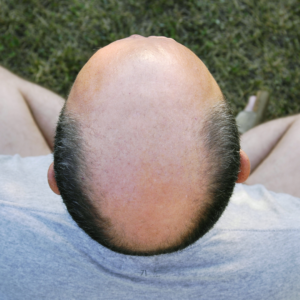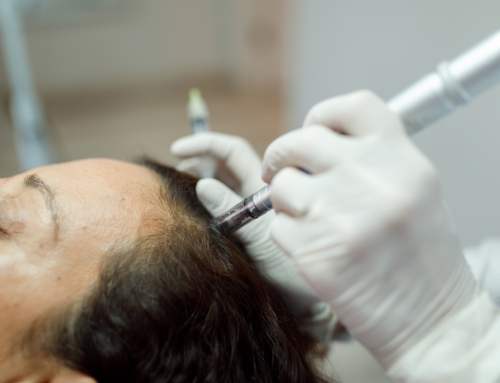Is hair loss connected to high cholesterol, calcification in the veins, and heart attacks?
Some studies seem to show there might be a connection. Let’s start with balding and non-balding patients.
Is Baldness Connected to Heart Health?
In one study (Goldman et al, 1996), where researchers compared balding vs. non-balding scalp tissue, they found that balding scalps produced finer, less pigmented hairs. These hairs were noticably less vascularized, as well.
When the researchers exposed these balding scalp cultures to a supplemental blood supply, the growth rate of the balding scalp cultures increased by approximately 80%.
In another study, the biopsies of balding scalps were accompanied by vascular thrombosis, (a blood clot inside a blood vessel that obstructs the flow of blood and nutrients to the hair follicle). Here again, you have a loss of vascularity.
In the final stages of pattern baldness, the study showed the tissue around the follicles gradually lost its capillaries. This occurred until the skin finally appeared to be deprived of blood vessels. There was a reduction in scalp oxygenation as well. Scientists also noted vascular insufficiency in the areas of the scalp that typically lose hair during the phases of male pattern baldness.
In 2010, Freund and Schwartz demonstrated that injections of botulinum toxin (botox) led to increased oxygen delivery to the frontal areas of the scalp. This resulted in a reduction of hair loss and new growth among men with pattern baldness.
The Role of Chronic Inflammation
Because our popluation is increasingly experiencing chronic inflammation and hormonal imbalances, our vessels and soft tissues slowly calcify. Over time, this leads to the tissues becoming more fibrotic – a condition where a wound heals abnormally, leading to scarring, thickening, and hardening.
While some people might not express this calcification and fibrosis at all, others do so by hair thinning (scalp calcification), others show it through heart disease, and utlimately heart attacks.
Microneedling and Reducing Fibrosis
The most scientifically validated method of reversing scalp calcification and fibrosis is through both energetic or mechanical stimulation through modulated acute injury.
The most promising, effective stimulation technique to date is through microneedlingm which is why it is a key component of the treatments we perform to reduce hair loss and regrow hair at Cellustrious®. The role that microneedling along with a nutritional supplement are key to hair health.
Help with Your Health and Hair
It’s important to find a provider who understands the link between the body and hair health. As Cellustrious® we understand they are not separate issues.
From your initial consultation to your ongoing treatment, we offer comprehensive support. We are here to answer your questions, monitor your progress, and adjust your treatment plan as needed to ensure the best possible outcomes.
Regrowing hair using plant-based peptides is a natural, effective, and superior alternative to Minoxidil. At Cellustrious, we are proud to offer this innovative treatment at our offices in Bradenton, FL, and soon near Phoenix, AZ. If you’re seeking a safe and sustainable solution for hair loss, contact us today to learn more about how plant-based peptides can help you achieve the hair regrowth results you desire.
**(Goldman et al. in 1996)






